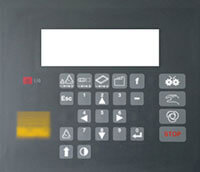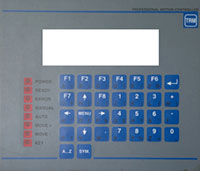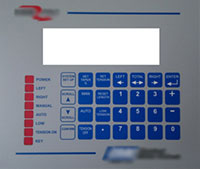The PMC Multi-axis Motion Controllers are high specification motion controls based on hardware and software specifically developed for the embedded motion control industry. Available in a range of sizes and enclosures, our motion controls are programmable with MAP, our software application. The PMC multi-axis motion controllers are suitable for automating a vast variety of machines i.e. glass rolling, tube forming, foil winding, XYZ profiles and many others. Should you have a machine that is, or is about to go into, production our development team will endeavour to assist in customising our motion controllers to suit your needs.
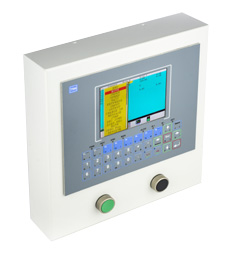 | 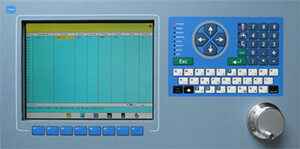 | 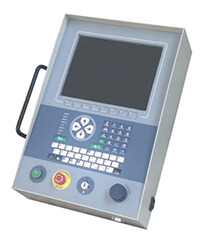 |
Our controllers can be used not only in motion control applications, but also in temperature control, data acquisition, open loop control, applications making it an affordable and simple solution as there is no need for an additional HMI or additional PLC. For some systems that do not require a LCD and keypad, we can supply the main board in a "blind" case and multiple units can be linked together if needed.
Applications:
| Features:
| Industries:
|
Software
Our motion controllers are intended for use on machines large or small that have a simple or complex process cycles. Programming is carried out in our MAP application which allows the machine builder or operator to create programs based on sequences of commands that are all available from easily navigable drop down menus. Once a command is selected, the parameter fields are completed and the next command chosen. There are over 100 commands to choose from and all are fully documented with examples, creating a program is just like filling in a spreadsheet. Should the user wish to code their own program, that is also possible in the popular 'C' language amongst others.
Controllers are shipped with an Operating System called Blackthorn which is entirely our own design and optimised for speed and stability in our motion controllers. It is worthwhile pointing out that this is not based on DOS, Windows or Linux so is not susceptible to the security issues, constant updates and virus attacks that each of them has. Boot time from cold takes only a couple of seconds and you can be ready to run a machine well within 10 seconds!
Our multi-axis motion controllers are designed from the outset to run cool, for 24 hours a day, 7 days a week, 365 days a year and to be stable and be accurate. We appreciate that downtime is valuable and MAP has a service menu built in along with notification messages to aid planned maintenance schedules.
A 2 axis motion control example using the MAP program
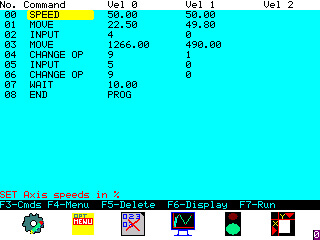
In the image opposite a simple program is shown that will control two axis and move to two locations to carry out a simple operation.
- Initially on line 0 the speed of each axis is set to 50% of the maximum allowed speed
- Secondly a move command is given and each axis will move to its corresponding position, in this case X=22.5mm and Y=49.8mm
- The system then waits for an input to switch before any further commands are processed.
- Once the input is in the correct state a move command is issued to send both axis to X=1266 and Y=490
- When in position an output is immediately turned on and the next line is processed
- This then waits for an input to change to 0
- Once the condition is met the next line changes the output to an off state
- The system then waits for 10 seconds before automatically starting again
This simple program can be expanded by selecting further commands which could be calculation based, time based, control other IO, results based on data received over serial comms and many many other options.
The PMC mult-axis motion controller can control AC/DC servo and stepper type motors. Below is a video of a Stepper being run up to a high speed however invariably most applications do not require a motor to run at full speed but under load and therefore at high current.
Running a Stepper Motor up to 9000RPM
|
Specifications Overview | ||||
| Axis: |
| None Volatile Ram: |
| |
| Programming: |
| High Speed RAM: |
| |
| Jog Wheel Encoder Inputs: |
| Sample Period: |
| |
| I/O: |
| Ports: |
| |
| Encoder Inputs: |
| Microprocessor: |
| |
| Encoder Registers: |
| Processing Speed: |
| |
| Step Controllers: |
| Flash Memory: |
| |
| Motion control: |
| Options: |
| |
Case Sizes
Other case sizes are available for our motion controllers to suit a variety of machines allowing door mounting, integrating into the machine itself, pendant mounting or even remotely mounting in a pedestal are a few of the options available.
Volume users
For volume users where standard doesn't fit, we have a customising service that allows case styles to be changed, overlays to be created with custom colours and logo's, and if necessary custom keypad layouts. Even the software can be semi-customised as standard opening screens can be added by uploading a JPEG image, Operator screens can be laid out by changing a few simple parameters and for those that want a full solution we can offer a design/installation or programming service.
Typical Connections.
Click to enlarge:
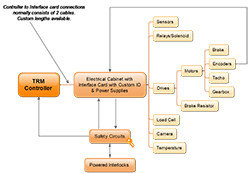 |  |
Custom Software
In the above examples the same motion controller is used however a new program is written to operate as required by the application. Keypad layouts or the screen position can be changed to suit the application.
Expansion boards
Sometimes more IO is required or specific power supplies, Analogue conditioning, relays, connectors and even the positioning of connections to make cable runs as neat as possible. We therefore provide a range of IO boards to integrate into a machine that link to the motion controller and makes wiring considerably easier. Depending on volume these can also be designed to suit the machine.
Customised Controllers
Customisation can be as simple as adding your logo or changing colours! We can revise the motion controllers overlay as needed and upon customer approval have a number produced so that the motion controller is branded and is styled the same as the machine it is mounted in. This appeals to OEM's as it is a key selling point and can give a consistent look across a range of machines.
We can also help with machine design, cable routing and specifying electrical components through to a full design/prototype process. As we have worked with many manufacturers of machines over the years we have a wealth of knowledge that you can call on to ensure your machine has the most competitive edge possible. Sometimes the cheapest way of doing things is not the best and it is the best that we will always look to provide.If you have a requirement that you need to fulfil please contact us.
|
| 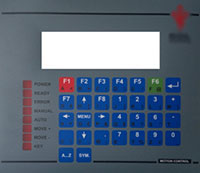 |
Specifications in Detail
Controller Power Supply:
The controller is supplied from a single 24VDC source in most applications. It can run from 12V to 32V however higher voltages will be clamped as the controller has internal protection.
Command Outputs:
There are four +/-10V motion control outputs available for connections to AC or DC drives. These provide the command signals to position each axis accurately. Each axis can be setup as servo or stepper so that a mixture can be used where precision needs to be delivered at a price.
Stepper Signals:
It is also possible to control four Stepper motors instead of servo or AC motors via the Step and Direction signals provided for each axis. This type of motor whilst more cost effective has it's limitations and if precise movements are required Servo motors should be used. (also see TTL Outputs).
TTL Outputs:
If the stepper signals are not used, they can be configured as eight general purpose TTL (0-5V) outputs. Capable of driving LED's, the output power is limited but can be buffered and used to drive much greater loads.
Internal Jog Encoders:
The PMC controller has provision for up to three low resolution encoder connections. These can be used as control dials for setting speed, adjusting position manually or altering values on screen by using our MAP software functions. Depending on the controller style chosen and order requirements, all, some or none of these may be fitted.
Inputs:
Sixteen opto-isolated inputs are available for connection to switchgear, Sensors, PLC's etc. Polarity is user selectable for PNP/NPN use in banks of 4 so it is possible to use a mixture of signalling methods.
Encoder Inputs:
We provide four encoder channels for use with servo motors. The signals available for each channel are A, B, /A, /B and Z. Settings available in MAP allow for the number of pulses to be programmed and if it is a rotary or linear type.
Outputs:
There are twelve 3 amp outputs that have current limiting built in to ensure no damage can be caused. Each bank of four outputs has a status signal that is fed back to the control software to enable an alarm should an error occur.
The output voltage can be selected by the installer as the VCC pin is available for external connection. Most installations have this linked to the supply pin however it allows other supplies to be used at a different voltage if required. Typically this is 24V however up to 36V can be used as a maximum with the lowest being 6V. The controller itself should be run from 12-24V as a standard.
A clamping diode is provided on each output to prevent energy spikes from inductive loads damaging the output device. These are only 1 amp devices with a 30 amp non-repetitive peak current which are suitable for most small relays etc. Contactors and larger inductive loads should always be suppressed at source with an appropriate device to prevent any noise transmission back to the controller.
Communications:
RS232 is fitted as standard along with RS485. CAN is currently an option though we plan to move our products onto this standard as a preference. Controllers can be connected to Computers, Printers and to other controllers as required to enable data to be uploaded or downloaded.
RS485 is a multi-drop format and nodes need to be configured with a logical number. We provide for 256 address' which is usually more than enough as Custom modules can be manufactured if needed to provide for specific IO.
Memory:
The PMC controllers have the facility to expand the internal memory if required with the use of SD cards. Designed to be installed at production, controllers should be ordered with this option if required.
Keys:
Depending on the case design and software, controllers can come with many different keypad layouts. Products designed for specific basic tasks may only have a few keys for navigation and data entry.
Where files are to be stored a compact alpha numeric keypad may be used but where data entry and modification is to be used regularly every hour of each day we have different layouts of full QWERTY keypads designed for fast data entry.
Displays:
Controllers can come with many different display options depending on the size of machine, location and information to be displayed. Typically we have 5.7” and 10.4” displays as standard although custom designs have used 1” and 3.5” and other sizes are available. While monochrome used to be the standard, virtually all controllers now use colour displays. This is not only due to the low cost but also as colour messages can instruct or warn an operator more effectively.
Enclosures and Mounting:
Custom enclosures are available depending on quantity and can be designed in conjunction with the customer to fit the machine. Standard enclosures are available and are suitable for many machines without modification.
Panel, POD and Boom Arm are all different types of mounting that are available to suit a wide variety of machines, if you don't see an option suitable please contact us with the required details.
Connections:
Most controllers are fitted with three D type connectors. A 37 way for Power, Digital Inputs and Power Outputs. A 44 way for Stepper signals, command signals, encoders and Analogue. And a 15 way for Serial communications.
A USB type A connection is also provided for Pen drive use.
Analogue Inputs:
Four inputs are provided with a +10/-10V range that can be easily converted externally to different ranges e.g. 4-20ma or 0-2V. Internal capacitors are fitted at 47pf however these can be modified by special order to suit the application.
A typical application for the inputs is monitoring load cells. Values can be read in to the controller and either averaged or the Max and Min found to enable calculations to be performed and outputs be controlled as needed.
PLC Inputs:
Four extra PNP Inputs IP16:19 are provided where outputs OP16:19 are not used. If, however, the outputs are used the inputs can then be used to monitor the output state to determine if the output is actually on or has failed.
Amplifier Enable:
The transistor output of an opto-coupler is provided for connection to a drive enable circuit. When motion commands are used and the system is told to run, the Drive enable signal is activated to allow movement of the axis.
Real Time Clock:
Although in most applications the use of time and date is not required, there are some where data needs to be recorded or maintenance schedules met. A battery backed RTC is provided for this requirement. Laser trimmed, these devices are highly accurate and facilities are provided to allow the system manager to change the date and time according to their time zone and time of year.
Protective Window:
All our controllers use a 6mm hard coated window to resist scratches and provide strength to prevent damage to the LCD display that would otherwise be easily damaged. This is bonded in place to also provide a seal to prevent dirt and liquids entering the controller.
Overlay:
A polyester overlay is bonded to an Aluminium front plate of between 2mm and 3mm thick depending on the controller. This gives great strength and noise immunity whilst being readily changed to suit customers needs. An over can be customised with a company Logo, company colours or a complete re-design changing the key lettering too.
Software:
As our controllers run from TRM's own operating system, the customer can choose to create their own Bespoke software which will run on the controllers to allow control of a process or machine to suit the customers requirements. If something more "off the shelf" is required our powerful programming language MAP may be used:
MAP:
This is a programming language that we have developed over many years that is now extremely powerful and flexible; there are not many machines that cannot be controlled.
All IO can be handled using this software along with completing basic and complex calculations. Values can be stored in any of the 256 registers that alone can be configured as Integer, Floating Point (values with a remainder or fraction), Signed Integer (32 bit), Unsigned Integer (32 bit).
Position of each axis can be controlled and set from direct values, calculated values, operator entered values or from values entered using the Jog dial input.

